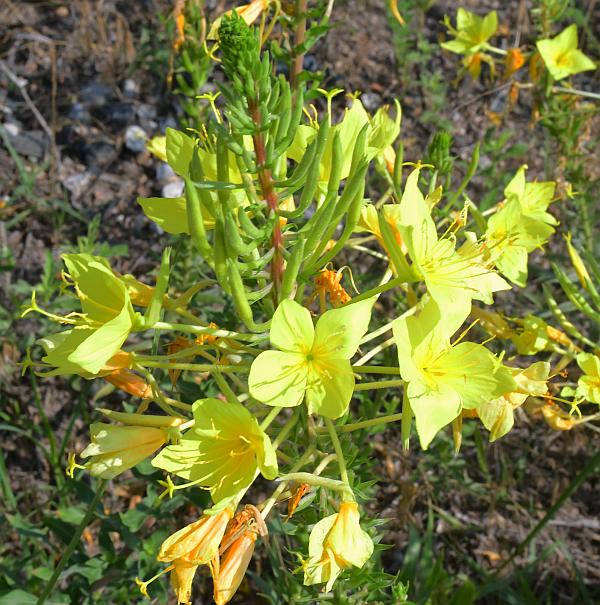Oenothera rhombipetala Nutt. ex Torr. & A. Gray
Sand Primrose

Native
CC = 5
CW = 3
MOC = 2
© SRTurner
Oenothera rhombipetala Nutt. ex Torr. & A. GraySand Primrose | |
 |
Native CC = 5 CW = 3 MOC = 2 |
© SRTurner |
|
Family - Onagraceae Habit - Taprooted biennial forb. Stems - Ascending, arched upward, or erect, to 1.0 m, 1 to several, unbranched to well-branched, sparsely to densely pubescent with short, appressed, nonglandular hairs (the plants generally appearing green or grayish green), sometimes also with minute glandular hairs toward the tip.
Leaves - Basal and alternate, the rosette leaves occasionally absent at flowering, 6-20 cm long, 6-20 mm wide, the blade narrowly oblanceolate, long-tapered to the sometimes short or indistinct petiole, the margins bluntly toothed to deeply pinnately lobed with the terminal lobe larger than the lateral ones, the surfaces and margins usually densely pubescent with short, appressed, nonglandular hairs; stem leaves 3-15 cm long, 8-25 mm wide, narrowly elliptic to narrowly lanceolate or narrowly oblanceolate to ovate, narrowly angled to truncate at the base, the margins variously toothed to pinnately lobed or occasionally nearly entire, with pubescence similar to that of the basal leaves, the secondary veins relatively inconspicuous.
Inflorescences - Dense spikes, the mature buds not overtopping the tip of the inflorescence axis, straight, the subtending bracts persistent, 8-25 mm long, narrowly lanceolate to narrowly ovate, the margins entire to few-toothed, broadly angled or rounded at the base, the pubescence similar to that of the leaves.
Flowers - Actinomorphic, opening at dusk, the floral tube 30-45 mm long, sparsely to densely pubescent with short nonglandular hairs and sometimes also minute glandular hairs. Sepals 15-30 mm long, sparsely to moderately pubescent with short nonglandular hairs, sometimes also minute glandular hairs, sometimes flecked with red spots, the free tips in bud 0.5-2.0 mm long, terminal, erect and appressed. Petals 15-35 mm long, 12-30 mm wide, broadly elliptic to more or less rhombic, usually pointed at the tip, lacking a stalklike base, yellow, fading to yellow to pale orange. Stamens with the filaments 13-23 mm long, glabrous at the base, the anthers 3-8 mm long, light yellow to yellow. Style 25-50 mm long, the stigma elevated above the anthers, deeply 4-lobed, the lobes 2-5 mm long.
Fruits - Capsules 13-25 mm long, 2.5-3.0 mm wide, cylindrical, usually curved, longitudinally dehiscent nearly the entire length, 4-locular, more or less circular to very bluntly 4-angled in cross-section, the surface green, moderately to densely pubescent with short, appressed, nonglandular hairs, sometimes also with sparse, minute glandular hairs. Seeds numerous in each locule, arranged in 2 rows, 1.0-1.7 mm long, 0.4-0.7 mm wide, ellipsoid, not angled, the surface brown, sometimes flecked with dark red spots, pitted. Self-incompatible.
Flowering - June - October. Habitat - Open sandy areas, roadsides. Origin - Native to the U.S. Lookalikes - O. fruticosa, O. clelandii, O. biennis, and others. Other info. - This showy species in rare in Missouri, and may no longer exist in the state at all. It is more common in some areas of the Plains states, where it can be locally abundant along roadsides. The plants are characterized by dense inflorescences of bright yellow flowers and cylindrical fruits which do not taper. The flower stigmas are 4-parted and raised well above the stamens, and the petals are typically rhombic and bluntly pointed at the tips. Prolific stands of the plants are an indicator of sandy substrate. Photographs taken along a roadside south of the Buffalo County Recreation Area, Buffalo County, NE, 8-21-2012, and along a roadside northwest of Anselmo, Custer County, NE, 7-15-2021 (SRTurner). |